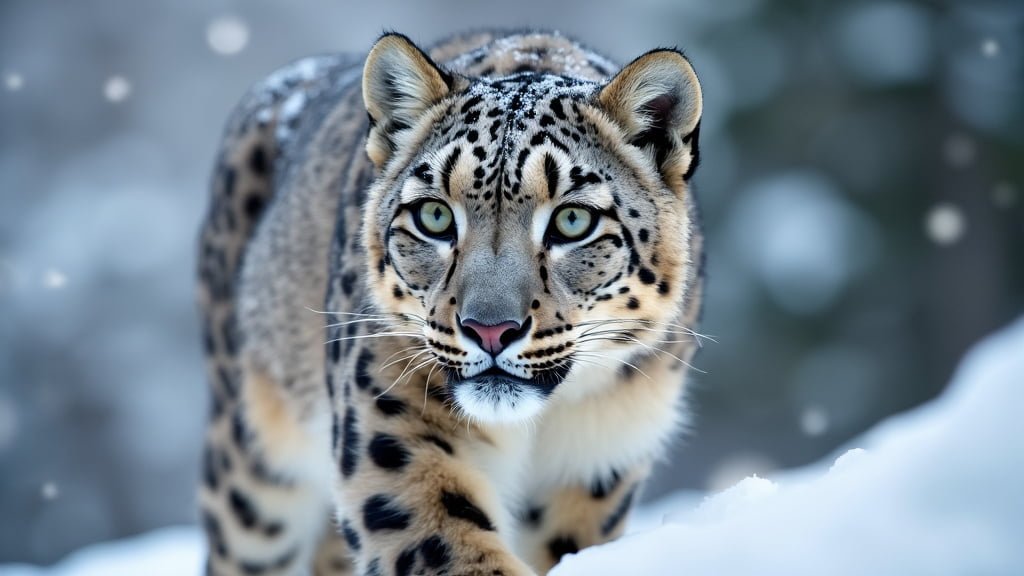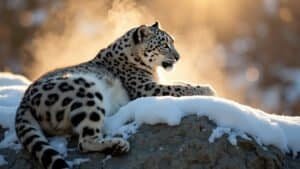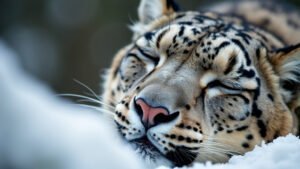Introduction
Panthera’s Snow Leopard Program is at the forefront of conservation efforts aimed at protecting one of the most elusive and endangered big cats in the world. This article explores the program’s key strategies and its impact on preserving snow leopard populations across their native habitats in Central Asia
We will delve into the primary goals of the program, the critical role of community involvement, the challenges faced, and the measurable outcomes that have emerged. By understanding Panthera’s approach, we gain insight into how effective conservation efforts can safeguard endangered species for future generations
Main Goals of Panthera’s Snow Leopard Program
Panthera’s Snow Leopard Program is driven by several key goals aimed at ensuring the survival and thriving of snow leopard populations in the wild
Given that snow leopards inhabit some of the most remote and rugged terrains in Central Asia, the program focuses on a multifaceted approach to conservation. These goals are vital not only for the preservation of the species but also for the maintenance of the broader ecosystems in which they play a critical role
Preservation of Habitat
One of the primary goals of Panthera’s Snow Leopard Program is the preservation and protection of the snow leopard’s natural habitat
Snow leopards are spread across twelve countries in Central Asia, with habitats ranging from the mountainous regions of the Himalayas to the high-altitude plateaus of Mongolia. Preserving these vast, often fragmented landscapes is essential for the survival of the species
Panthera works closely with local governments and communities to establish protected areas and corridors that allow snow leopards to move freely between habitats. By maintaining these connections, Panthera helps ensure genetic diversity within the population, which is crucial for the species’ long-term viability
For instance, the establishment of transboundary conservation areas in regions like the Altai-Sayan ecoregion has been pivotal in connecting populations across national borders
Additionally, Panthera engages in habitat restoration projects where degradation has occurred due to human activities such as overgrazing or infrastructure development
These efforts include reforestation, controlling livestock grazing, and implementing sustainable land-use practices that benefit both wildlife and local communities
Reducing Human-Wildlife Conflict
Human-wildlife conflict is a significant threat to snow leopard conservation, particularly as human populations encroach further into snow leopard territories. Panthera’s program places a strong emphasis on reducing such conflicts to foster coexistence between snow leopards and local communities
One of the ways Panthera addresses this is through compensation schemes and insurance programs for herders who lose livestock to snow leopard predation
These initiatives are designed to reduce retaliatory killings, which have been a major cause of snow leopard mortality. By providing financial incentives, Panthera encourages herders to adopt non-lethal methods of protecting their livestock, such as improved corrals and the use of guard dogs
Moreover, Panthera conducts extensive outreach and education programs aimed at increasing awareness about the ecological importance of snow leopards and the benefits of biodiversity. These programs help shift local perceptions from viewing snow leopards as pests to valuing them as integral parts of the ecosystem
Scientific Research and Monitoring
Another critical goal of Panthera’s Snow Leopard Program is to advance scientific research and monitoring of snow leopard populations
Accurate data on population size, health, and distribution are essential for effective conservation planning. To this end, Panthera employs a variety of advanced research techniques
One of the primary methods used is camera trapping, which has revolutionized snow leopard monitoring by providing reliable data on their abundance and behavior
Camera traps are strategically placed in remote areas to capture images and videos of snow leopards as they move through their habitats. These images help researchers estimate population sizes and understand movement patterns, which are crucial for creating effective conservation strategies
Additionally, Panthera collaborates with geneticists to analyze DNA samples collected from snow leopard scat (feces). This non-invasive technique allows researchers to assess genetic diversity and track individual snow leopards, providing insights into breeding patterns and population health
Panthera also uses satellite collars to track the movements of individual snow leopards. These collars provide valuable data on the range, migration routes, and habitat use, informing efforts to create and manage protected areas
The information gained from these monitoring techniques is shared with local governments and conservation partners to guide policy and on-the-ground actions
Community Involvement and Anti-Poaching Measures
A critical component of Panthera’s Snow Leopard Program is the involvement of local communities and the implementation of anti-poaching measures. Since snow leopards inhabit regions that are often populated by herding communities, the success of conservation efforts depends heavily on gaining the support and active participation of these communities
Additionally, combating poaching, which remains a significant threat, requires coordinated efforts at both local and international levels
Educating and Engaging Local Communities
Local communities play an essential role in snow leopard conservation, and Panthera has recognized that their engagement is key to the program’s success. Education and awareness campaigns are integral to Panthera’s strategy, aiming to foster a sense of stewardship among community members
Panthera works directly with herders, schoolchildren, and local leaders to educate them about the importance of snow leopards and their role in the ecosystem. These educational efforts emphasize the economic and ecological benefits of conserving the species, including how snow leopards contribute to the health of prey populations and the broader environment
One notable initiative is the establishment of Snow Leopard Enterprises, a program that provides training to local communities in producing and selling handicrafts
The income generated from these crafts not only improves the economic well-being of community members but also creates an incentive to protect snow leopards. In exchange for their participation, communities agree to cease hunting snow leopards and their prey, leading to a direct reduction in poaching and retaliatory killings
Moreover, Panthera supports the development of community-managed conservation areas where local people take the lead in protecting snow leopard habitats. These areas serve as models of sustainable land management and demonstrate the potential for conservation to coexist with traditional livelihoods
Anti-Poaching Initiatives
Poaching remains one of the most pressing threats to snow leopard survival. Driven by demand for their pelts and bones, snow leopards are often targeted by poachers, and their prey species are also hunted, leading to food shortages for the leopards. Panthera’s anti-poaching initiatives are designed to tackle this issue from multiple angles
Panthera collaborates with local law enforcement and wildlife protection agencies to strengthen anti-poaching efforts
This collaboration includes training rangers in modern surveillance techniques and providing them with equipment such as drones and GPS devices to monitor vast and often inaccessible landscapes effectively. These efforts are complemented by the use of camera traps and other technologies to detect and deter poaching activities
Additionally, Panthera supports the development of intelligence networks that gather information on poaching operations. By working closely with local communities and informants, Panthera helps authorities identify and apprehend poachers before they can harm wildlife. This proactive approach is vital in areas where enforcement resources are limited
Panthera also addresses the demand side of the poaching problem through awareness campaigns that target markets for snow leopard products. By educating consumers about the impact of their purchases, Panthera aims to reduce demand for illegal wildlife products, thereby decreasing the incentive for poaching
Collaborations with Governments and NGOs
Panthera’s Snow Leopard Program collaborates extensively with governments and non-governmental organizations (NGOs) to enhance the effectiveness of its conservation efforts. These partnerships are crucial for addressing the transboundary nature of snow leopard habitats, as well as for leveraging resources and expertise
For example, Panthera has partnered with the Global Snow Leopard & Ecosystem Protection Program (GSLEP), an international initiative that unites governments from all 12 snow leopard range countries
This collaboration focuses on creating and implementing national action plans that align with global conservation goals. Through GSLEP, Panthera contributes to efforts such as standardized monitoring protocols and coordinated anti-poaching operations across borders
Moreover, Panthera works with local NGOs to implement community-based conservation programs. These NGOs often have deep roots in the communities they serve, enabling more effective communication and trust-building. By working together, Panthera and its partners can scale up successful initiatives, share best practices, and respond quickly to emerging threats
Collaborations also extend to research institutions, where Panthera supports scientific studies that inform conservation strategies
By pooling knowledge and resources, these partnerships enhance the overall impact of snow leopard conservation efforts, ensuring that they are grounded in the latest scientific findings and best practices
Challenges in Snow Leopard Conservation
Snow leopard conservation presents numerous challenges due to the species’ elusive nature, the harsh environments they inhabit, and the socio-economic factors affecting the regions where they live
Panthera’s Snow Leopard Program must navigate these difficulties to protect this endangered species effectively
Geographic and Climatic Challenges
The remote and rugged landscapes that snow leopards call home present significant challenges to conservation efforts. These cats are found in some of the world’s highest and most inhospitable mountain ranges, including the Himalayas, the Karakoram, and the Tien Shan
The extreme altitudes, often exceeding 10,000 feet, and harsh climatic conditions, including severe winters and short summers, make it difficult for conservation teams to access these areas and monitor snow leopard populations
These geographic challenges also complicate efforts to conduct scientific research. For instance, setting up and maintaining camera traps or tracking devices in such remote locations requires significant logistical planning and resources. The terrain limits the movement of field teams and the transportation of equipment, leading to higher costs and longer time frames for research projects
Furthermore, the fragmented nature of snow leopard habitats complicates conservation efforts. Snow leopards require large territories to support their solitary lifestyles and hunting needs, but human activities, such as mining and infrastructure development, are increasingly fragmenting these landscapes
This fragmentation reduces the available habitat for snow leopards and isolates populations, which can lead to inbreeding and reduced genetic diversity
Funding and Resource Constraints
Securing sufficient funding and resources is another major challenge for snow leopard conservation. Conservation programs, especially those operating in remote and politically unstable regions, require substantial financial investment to be effective
Unfortunately, funding for conservation is often limited and competitive, with many organizations vying for the same pool of resources
Panthera’s Snow Leopard Program relies on donations, grants, and partnerships to fund its operations. However, the costs associated with fieldwork, technology, community engagement, and anti-poaching efforts are high. For example, equipping and training rangers, maintaining camera trap networks, and supporting community conservation initiatives all require ongoing financial support
The fluctuating nature of funding also presents a challenge, as long-term conservation efforts need consistent financial backing. Without sustained funding, critical activities such as population monitoring, habitat protection, and community engagement can be disrupted, undermining progress made over years of effort
Addressing Illegal Wildlife Trade
The illegal wildlife trade poses one of the most severe threats to snow leopards. Despite international laws protecting snow leopards, the demand for their pelts, bones, and other body parts continues to drive poaching. The trade is often facilitated by organized crime networks that operate across borders, making it difficult to combat
Addressing the illegal wildlife trade requires coordinated international efforts, as well as strong enforcement of existing laws
However, in many snow leopard range countries, enforcement is weak due to corruption, lack of resources, and insufficient training. Even when poachers are caught, they often face minimal penalties, which fail to deter future crimes
Panthera works to address this challenge by collaborating with law enforcement agencies, local communities, and international partners to strengthen anti-poaching measures and crack down on illegal trade. This includes supporting the training of wildlife rangers, improving surveillance technologies, and advocating for stronger legal frameworks to protect snow leopards
Moreover, Panthera participates in awareness campaigns aimed at reducing demand for snow leopard products. By educating consumers, particularly in regions where traditional medicine and luxury markets drive the trade, Panthera hopes to decrease the economic incentives that fuel poaching
Impact and Future Directions of Panthera’s Program
Panthera’s Snow Leopard Program has made significant strides in conserving snow leopards, yet ongoing efforts and future strategies are crucial to securing the species’ future
This section will explore the program’s impact to date and outline the future directions that Panthera aims to pursue to continue their conservation success
Successes in Population Stabilization
One of the most notable achievements of Panthera’s Snow Leopard Program is the stabilization of snow leopard populations in key areas
Through a combination of habitat protection, community engagement, and anti-poaching initiatives, Panthera has contributed to halting the decline of snow leopard numbers in several regions
For example, in the Pamir Mountains of Tajikistan, Panthera’s work with local communities has led to a reduction in retaliatory killings of snow leopards. The introduction of livestock insurance schemes and predator-proof corrals has mitigated conflicts, resulting in a more stable population of snow leopards in this area
This model of community-based conservation has been replicated in other regions with similar success
Furthermore, Panthera’s scientific research and monitoring efforts have provided critical data that has informed conservation strategies not only for snow leopards but also for other species sharing their habitat
The use of camera traps and genetic analysis has improved our understanding of snow leopard behavior, population dynamics, and health, allowing for more targeted and effective conservation actions
Long-Term Strategies for Conservation
Looking ahead, Panthera is focused on implementing long-term strategies that will ensure the continued survival of snow leopards. These strategies include expanding protected areas, enhancing community involvement, and addressing emerging threats such as climate change
Panthera plans to increase the number and size of protected areas dedicated to snow leopard conservation. This includes advocating for the designation of new reserves and the expansion of existing ones to create larger, more connected habitats that can support viable snow leopard populations
The program also seeks to strengthen the management of these areas by improving the capacity of local authorities and community groups to protect and monitor wildlife
Another key aspect of Panthera’s long-term strategy is deepening its partnerships with local communities. By continuing to invest in education, sustainable livelihoods, and conflict mitigation, Panthera aims to build a conservation ethic that is ingrained in the daily lives of people living alongside snow leopards
The success of these community-based approaches is essential for achieving lasting conservation outcomes
In addition, Panthera is increasingly focusing on the impacts of climate change on snow leopard habitats. As global temperatures rise, the fragile ecosystems that snow leopards depend on are at risk
Panthera is working to identify and protect climate refugia—areas that are likely to remain suitable habitats as conditions change. This proactive approach is critical to ensuring that snow leopards have the space and resources they need to survive in a warming world
Expanding Conservation Efforts Across Regions
Panthera recognizes that snow leopard conservation cannot be limited to isolated areas and that a landscape-scale approach is necessary. Therefore, the program is expanding its efforts across the snow leopard’s entire range, which spans multiple countries and ecosystems
To achieve this, Panthera is fostering cross-border collaborations that facilitate the movement of snow leopards between different regions. This is particularly important in areas where political borders cut across the animals’ natural habitats
Through initiatives like the Global Snow Leopard & Ecosystem Protection Program (GSLEP), Panthera is working with governments to ensure that conservation policies are aligned and that snow leopards can move freely across national boundaries
Panthera is also expanding its use of technology in conservation efforts. Advanced tools like satellite tracking, drones, and artificial intelligence are being deployed to monitor snow leopards more effectively and to detect and prevent poaching activities. These technologies provide real-time data that can be used to make informed decisions about how best to protect snow leopards and their habitats
The program’s expansion efforts also involve scaling up community engagement projects to new regions where snow leopard conservation has traditionally been underfunded or overlooked
By bringing successful models from one region to another, Panthera aims to create a unified and effective approach to snow leopard conservation across their entire range
Conclusion
Panthera’s Snow Leopard Program has made substantial contributions to the conservation of this elusive and endangered species. By focusing on habitat preservation, community involvement, anti-poaching efforts, and scientific research, the program has successfully stabilized snow leopard populations in key areas
The program’s impact extends beyond immediate conservation, fostering sustainable practices and partnerships that benefit entire ecosystems. However, ongoing challenges such as climate change, habitat fragmentation, and illegal wildlife trade require continuous effort and innovation
As Panthera looks to the future, its commitment to expanding protected areas, deepening community engagement, and leveraging new technologies will be crucial in securing the long-term survival of snow leopards across their range
Through these concerted efforts, Panthera aims to ensure that snow leopards remain a living symbol of the world’s wild and remote mountain landscapes for generations to come











